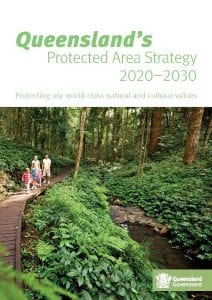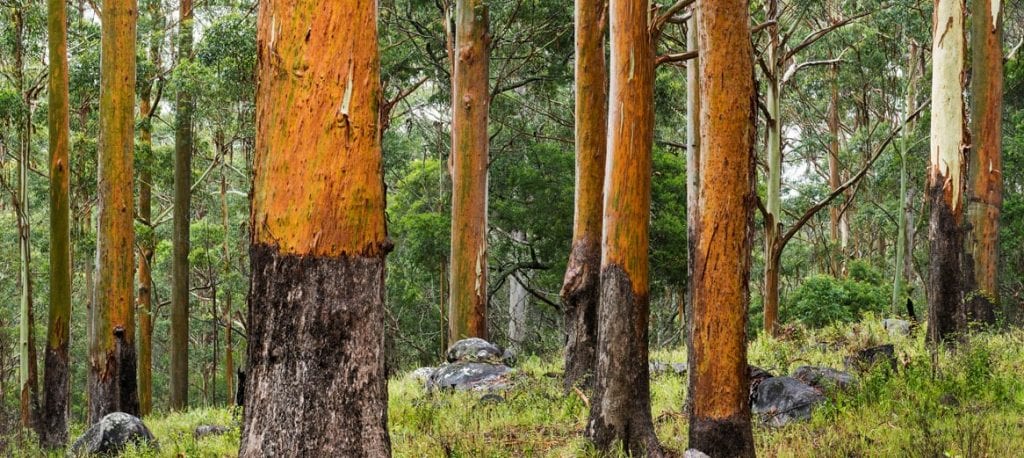Ecotourism, Indigenous Conservation, National Parks, Nature Refuges, Private Reserves, State Forests
Queensland’s new Protected Area Strategy

After much lobbying by the National Parks Association of Queensland and others, the Queensland Protected Area Strategy was finally released by the Government a few days before caretaker mode came into effect prior to the recent State election. The release of the Strategy has been one of the major requests of NPAQ as it will guide the State in moving towards the agreed upon IUCN target of 17% of Queensland land as protected area. Currently only some 8.26% of Queensland is designated as protected area, so there is a long way to go.
But, will the strategy be effective?
Overview
The Strategy is a comprehensive document that says all the right things and promises a better future for the State’s declining biodiversity, setting the strategic direction for the next 10 years. It acknowledges that there is an urgent need to halt global biodiversity decline. It identifies six reasons why protected areas are important:
- Climate Change – mitigating effects and enhancing resilience
- Threatened Species – refuges to prevent extinction
- Ecosystem Services – nutrient recycling, soil retention, pollination, water supply, natural buffers
- Connection to Country – spiritual and physical connection, cultural significance
- Health and well-being – physical and mental health from connecting with nature
- Economy – underpinning of ecotourism industry and supporting regional economies
It sets a mission “to enhance and maintain a system of world-class protected areas, guided by First Nations’ knowledge and expertise, global best practice and community needs, which ensures Queensland’s exceptional nature and culture are actively supported to thrive for future generations to experience and enjoy.”
It is worth keeping this Mission Statement in mind as we review the contents of the strategy.
Six objectives are set in the strategy:
- Improve conservation of biodiversity
- Create Regional jobs
- Increase resilience to climate change
- Support connection to country for First Nations people
- Secure innovative funding streams
- Deliver social, health, economic and cultural benefits
Three strategic priorities are established for the strategy, underpinned by six guiding principles. The strategic priorities are:
- Grow – expand the protected areas
- Care – manage in partnership with First Nations peoples, landholders and other land managers
- Connect – increase community engagement with national parks
Ten actions are then set for each strategic priority. A total of nine progress measures are identified, three for each strategic priority.
A number of detailed actions are listed for each of the ten main actions. Implementation of the strategy is proposed as a staged approach. Implementation is to be evaluated systematically in line with the nine progress measures and in accordance with Queensland Government Program Evaluation Guidelines. This is to be detailed in an Evaluation Plan – not provided with the strategy. Progress will be reported and published on a “regular” basis. A report card will detail progress against the strategy’s objectives annually.
Assessment
The strategy does well in setting a vision, mission, strategic direction, objectives and actions. It has a strong emphasis on working in partnership with First Nations people. It is supportive of growing ecotourism opportunities, particularly through ecotourism trails, and places emphasis on finding “innovative funding streams” to support Government budgets. This would have more credibility if examples were given of where this has worked successfully elsewhere. It is difficult to get private investors to fund/co-fund core Government functions.
The obvious omission in the strategy is the lack of measurable targets that can drive the stated actions and support budget bids to ensure that such targets are met. Without targets, it will be difficult to hold the Government accountable for successful implementation of the strategy.
There is no indication in the strategy of time frames for the listed actions. The nine Progress Measures are high level and mostly do not seem to be related to key actions. For example, one action under the strategic priority of “Care” is to prioritise protection and recovery of threatened species in national parks, but there is no stated measure about improving the status of threatened species.
The lack of targets is the biggest weakness of the strategy. Under the strategic priority of “Grow” there are progress measures of “proportion of Queensland’s land area secured in protected areas” and “extent of lands managed as private protected areas”. These progress measures are not quantified. Would a 1% increase in protected areas over ten years be a success? Without accountable targets, annual budget allocations will drive implementation rather than Government endorsed targets.
The strategy proposes an annual report card to detail progress against meeting the objectives. Again, without targets this is likely to be a rather general exercise, especially as there does not seem to be a Report Card on the status of much of the protected area estate as it exists today. How do you report on progress without a clear starting point?
Can the Strategy succeed?
To have any confidence that the strategy will be successful in achieving the stated mission and progressing Queensland towards its stated target of 17% of land as protected area, an Implementation Plan will be required driven by an inter-agency Steering Committee to ensure whole of Government commitment.
The Implementation Plan would complement the Evaluation Plan and should detail a timetable and targets for at least the ten actions set under the three strategic priorities. This would then show what actions are proposed over what period of time to achieve the targets. Ideally, the Implementation Plan should also show an indicative costing over each year of the ten-year time span which would underpin annual budget bids. In line with the strategic priority of “Connect” and “increasing community engagement with National Parks” a Community Reference Group should be considered to support the Steering Committee in implementing the strategy.
Next Steps
To date, the Government has announced a $60 million “down payment” over four years with $28m allocated for expansion of National Park and other public protected area, $8m for nature reserves/refuges and $5.2m for revitalising national parks. This is a long way from what is needed, so further public and innovative funding will be required to make meaningful progress.
We acknowledge that the Protected Areas Strategy does set a clear direction for the next ten years. With the election over, NPAQ will seek meetings with the minister and senior bureaucrats to press for early action through the development of an Implementation Plan with clear targets, timelines, indicative budget and accountabilities driven by a Steering Committee and supported by a Community Reference Group. The forthcoming budget will be a strong indication of the level of Government’s commitment. Achieving the stated Mission will not be possible without budget allocations that reflect the value of protected areas to Queensland’s economy.

